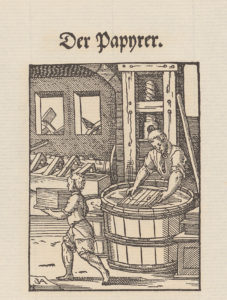
Series: Book Printing in Europe
Civilisation would be not the same without book printing. The history of an extraordinary invention.
The invention of printing is generally associated with the name of Johannes Gutenberg (1400 ‒1468), who introduced the process in Mainz in around 1450. The possibility of producing hundreds and thousands of copies within a relatively short time span revolutionized the media world in the early years of the Modern Age. Whereas a medieval copyist working in a monastery scriptorium needed three years to complete a single manuscript of the Bible, Gutenberg printed 180 copies in the same amount of time. By around 1470, the prices of printed books began to fall below those of works written by hand, thus making texts even more readily available. The increasingly close-knit network through which knowledge could be accessed accelerated the processes of scholarly interaction and scientific progress. The cultural impact of the invention of printing, reflected in developments ranging from a rising level of popular literacy to the establishment of numerous libraries, cannot be overestimated. Yet what is often attributed to Gutenberg actually took root thousands of miles to the east, in China. It was there that printing — and paper itself — were invented.
The invention of Paper
Had it not been for paper, book printing would never have flourished as outlined above. The skins of eighty animals were needed to print a single Gutenberg Bible on parchment. Gutenberg printed 180 copies, of which fifty have survived to this day. It would have taken 14'400 animal hides to print that many Bibles on parchment. The picture assumes even more dramatic proportions when we consider that more than 27'000 incunabula were printed in editions averaging 400 copies each. Based on a cautious estimate of twenty skins per book, a grand total of 216'000'000 animals would have been needed to produce all of the books printed in the fifteenth century. Thus it is easy to see that paper was a welcome substitute for parchment and a prerequisite for further growth in book production.
The birthplace of paper was located in the border region between central and southern China in the pre-Christian era. According to the paper historian Peter F. Tschudin of Basel: The oldest items of paper found in China to date appear to suggest a process of evolution from a felt-like material made of textile plant fibers to actual paper. Unfortunately, the process has not been dated with certainty, but Chinese sources place the introduction of paper production in the pre-Christian era. Thus there is compelling evidence that the production of “proto-paper” in a wet-laid nonwoven process first took place during the Qin or Han Dynasty, at the very latest. T’sai Lun, who is credited according to the Hou Han Shu, the official chronicle of the Han Dynasty, with having invented paper in AD 105, refined the previously existing technique and replaced fresh plant fibers with recycled textile fibers.
Paper production spread rapidly throughout China, reached Korea in the fifth century, and is said to have been introduced in Japan by the Korean monk Damjing in 610. The Arab peoples in territories west of China also learned to produce paper early on. The new writing material arrived in Samarkand (5th or 6th cent.), followed by Baghdad (8th cent.), Cairo (9th cent.), and the Turkish and Greek-Byzantine regions (11th cent.). The first paper mills in Europe were founded on the Iberian Peninsula and the Balearic Islands. Paper was presumably produced in Italy in the early thirteenth century. The earliest paper mills in Germany were established by business magnates in Nuremberg in 1390 and in Ravensburg in 1391. Roughly ten mills were in operation around 1450, most of them in the Upper Rhine region. A paper mill produced between 1000 and 1800 reams per year. One ream corresponds to roughly 500 sheets of paper, each of which could be divided into four folio-sized pages. It took 108 reams of paper to print a single Gutenberg Bible, which explains why supply shortages occurred at times. Although paper was four times cheaper than parchment, investments by printers were still quite substantial, as a ream of paper cost between sixteen and eighteen schillings in Basel around 1470 — the equivalent of eleven days’ wages for a journeyman tailor. The paper required to print Bartholomaeus Anglicus’s encyclopedia De proprietatibus rerum alone, a work comprising 248 folio sheets printed in Cologne in 1471 ‒72 (in an edition estimated at 120 copies), cost fifty to sixty guilders, or roughly the price of a small house.
In Switzerland paper was first produced in the early fifteenth century. The earliest production plants were located near Geneva, Fribourg, and Basel. European paper production differed from its Far Eastern counterpart in a number of ways, which were reflected in gains in both quality and productivity. The most important innovations affected the pulping machine and its drive system, the sieve fashioned from metal wire, and, somewhat later, the gluing and calendering processes.

Parchment was the perfect material to produce books. But the need of animal skins was too high. Photo: Zentralbibliothek Zurich

Paper production was treated as an art. This woodcarving of 1568 shows the daily work of an operator. The image was printed in Jost Ammans "Ständebuch". Photo: Zentralbibliothek Zurich
A short documentary about the history of paper.
The start of book printing.
Read part 2:



